Assessing Local Communities’ Willingness to Pay for River Network Protection: A Contingent Valuation Study of Shanghai, China
Abstract
:1. Introduction
- (1) Estimate the benefit of river network protection and analyze factors affecting the WTP and the regional disparity in the WTP between urban and suburban areas.
- (2) Evaluate the public’s awareness of and attitude toward the river network and its protection.
- (3) Propose suggestions for the integrated protection of the river network based on the above results.
2. Study Area

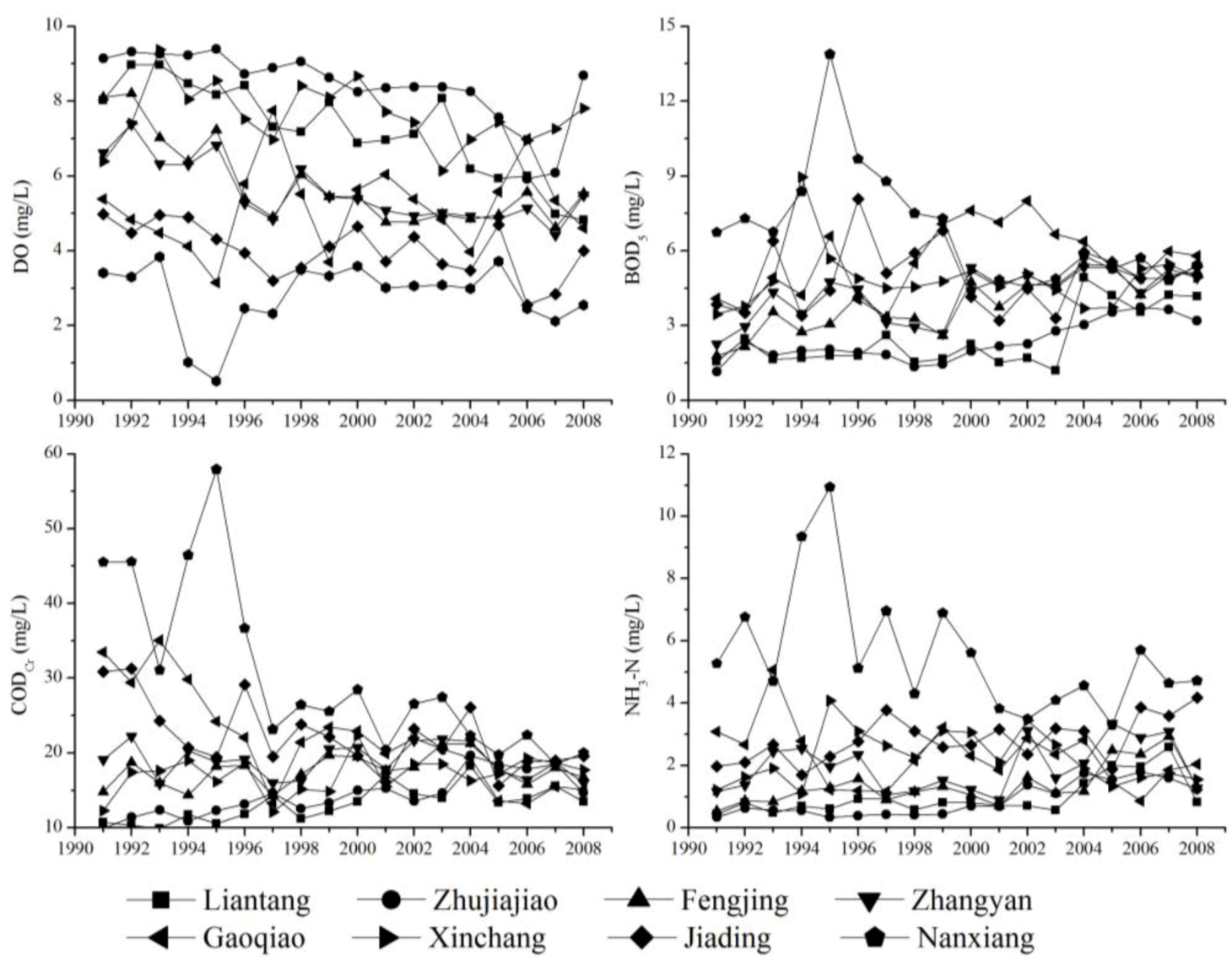
3. Materials and Methods
3.1. Design of Questionnaire
- Would you pay money to financially assist the government for the improvement of river network (raise connectivity of river network, improve water quality, build riparian zone to make it a proper place for amusement and recreation?A. Yes (Please follow with Question 2) B. No
- Considering your household expenditures, are you willing to pay (a bid amount) money (per month) from your household income for river network improvement in the next 5 years so that the government could implement this program?A. Yes B. No
3.2. Data Collection and Valuation Approach



4. Results and Discussion
4.1. Socioeconomic Characteristics
| Item | Response | Percentage (%) | Item | Response | Percentage (%) |
|---|---|---|---|---|---|
| Age | ≤20 | 8.85 | Household income (RMB per month) | 0–500 | 1.88 |
| 21–30 | 41.43 | 500–1,000 | 3.58 | ||
| 31–40 | 19.02 | 1,000–2,000 | 11.68 | ||
| 41–50 | 14.12 | 2,000–3,000 | 15.07 | ||
| 51–60 | 9.23 | 3,000–5,000 | 20.90 | ||
| >60 | 7.34 | 5,000–8,000 | 19.59 | ||
| Job | Civil Servant | 1.32 | 8,000–10,000 | 7.72 | |
| Researcher | 1.13 | 10,000–15,000 | 6.59 | ||
| Manager | 6.97 | 15,000–20,000 | 5.84 | ||
| Medical staff | 1.51 | 20,000–30,000 | 3.20 | ||
| Teacher | 1.69 | >30,000 | 3.95 | ||
| Worker | 35.40 | Distance to river | 0–500 m | 51.04 | |
| Private enterprise | 11.11 | 500–1,000 m | 22.22 | ||
| Farmer | 2.82 | 1,000–2,000 m | 12.81 | ||
| Student | 14.88 | 2,000–3,000 m | 4.14 | ||
| Retired | 9.79 | 3,000–5,000 m | 3.20 | ||
| Unemployed | 2.82 | >5,000 m | 6.59 | ||
| Others | 10.55 | Years lived in Shanghai | <1 Year | 11.11 | |
| Education level | Middle school and below | 22.03 | 1–5 Years | 27.87 | |
| High school | 38.79 | 5–10 Years | 18.27 | ||
| Vocational school | 17.89 | 10–20 Years | 14.69 | ||
| University | 14.50 | >20 Years | 28.06 | ||
| Graduated | 6.59 | Job-related influence | Yes | 36.16 | |
| Household population | 1 | 1.69 | No | 63.84 | |
| 2 | 6.40 | District | Urban | 38.5 | |
| 3 | 45.95 | Suburban | 61.5 | ||
| 4 | 21.09 | ||||
| 5 | 16.01 | ||||
| ≥6 | 8.85 |
4.2. Value Orientation toward River Network
4.3. Recognition of Functions and Services
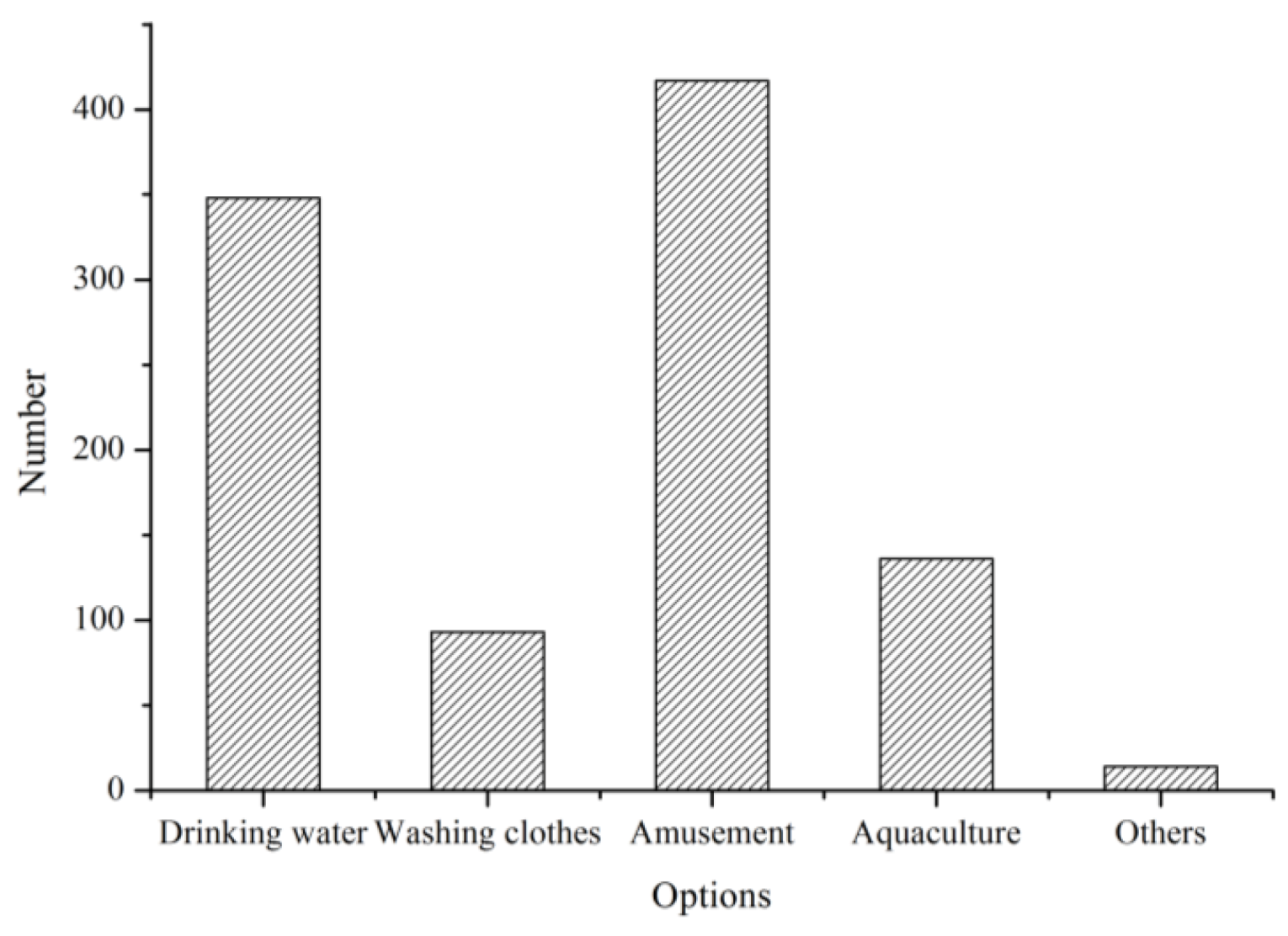
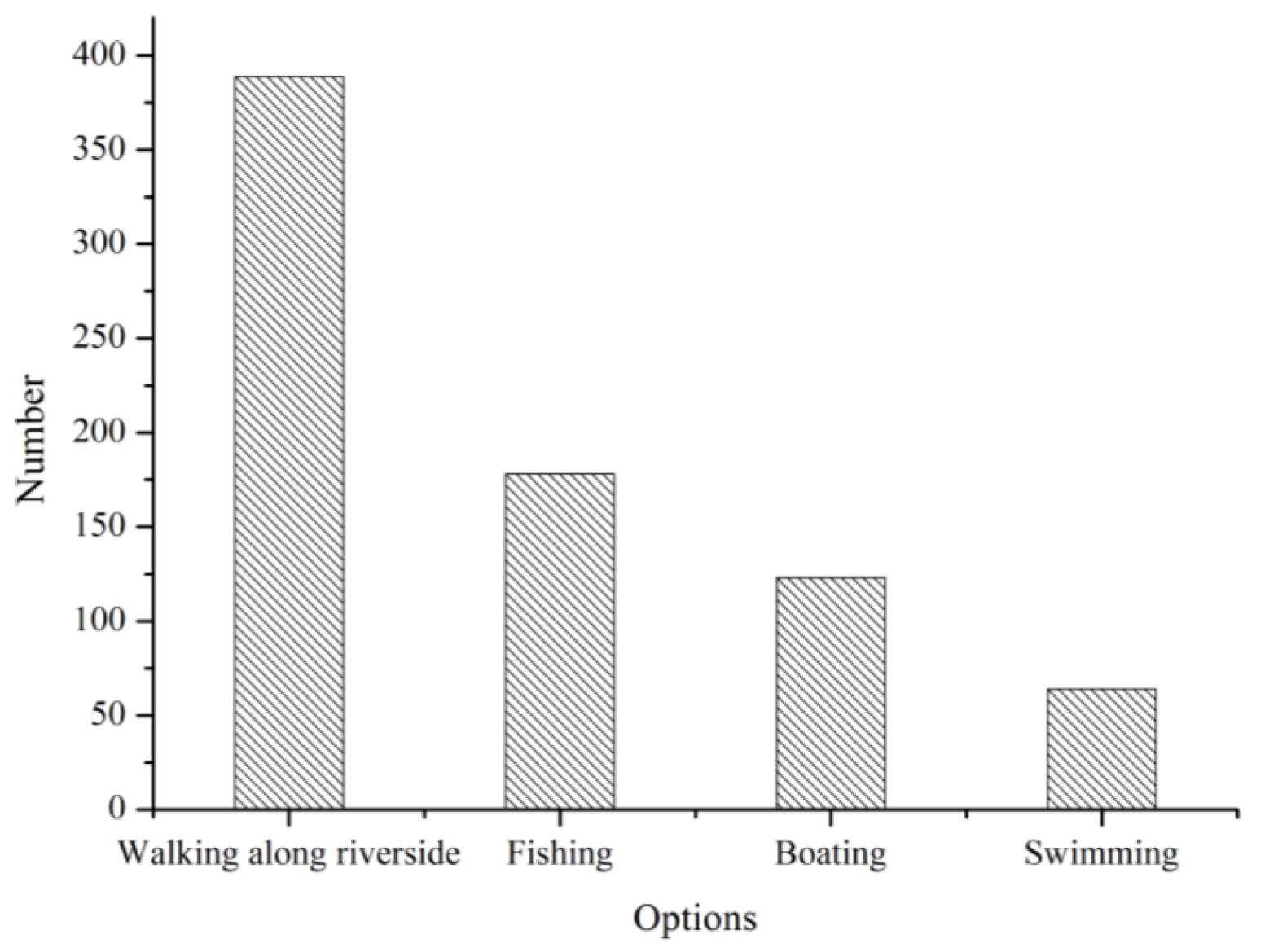
4.4. Awareness of Destruction and Protection
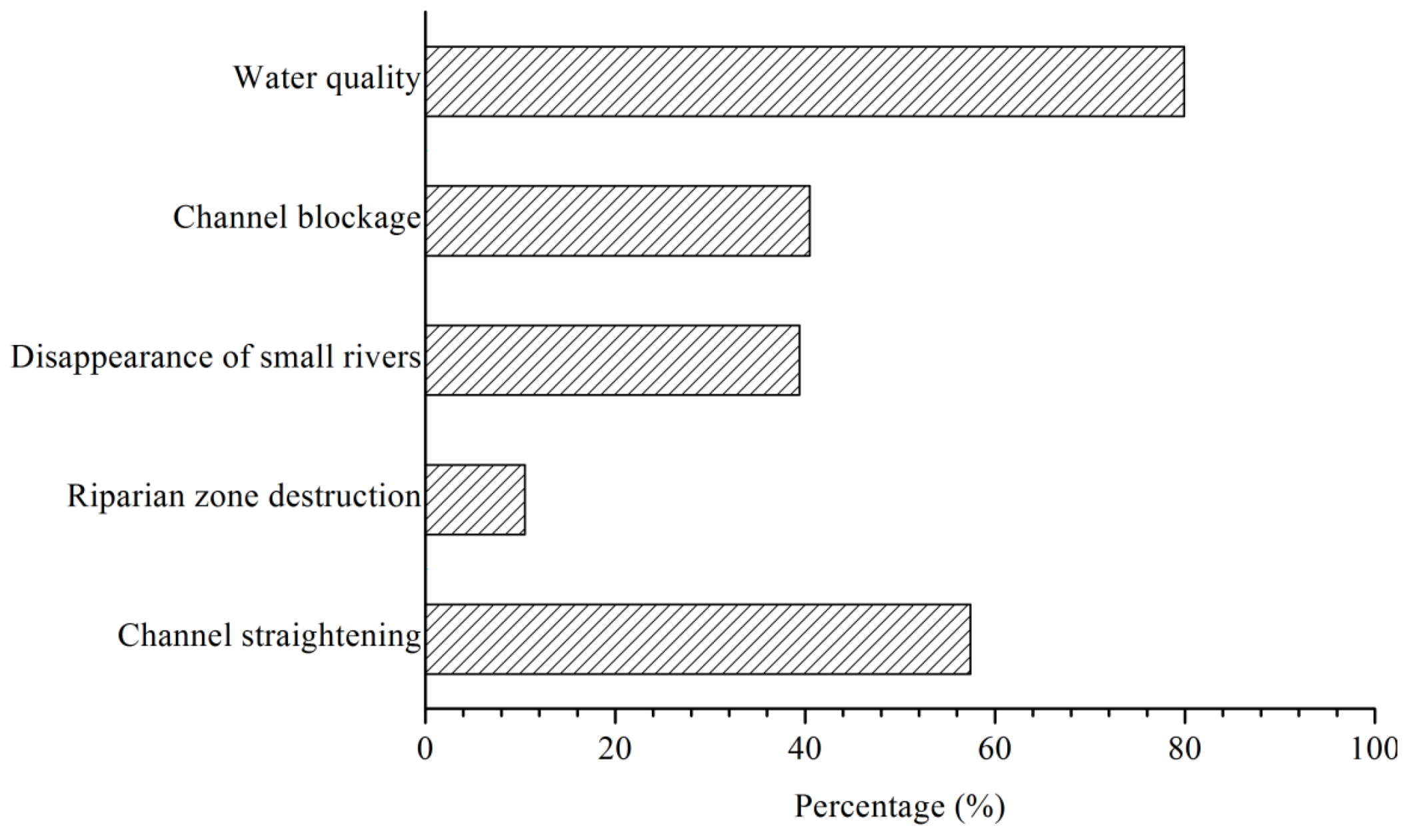
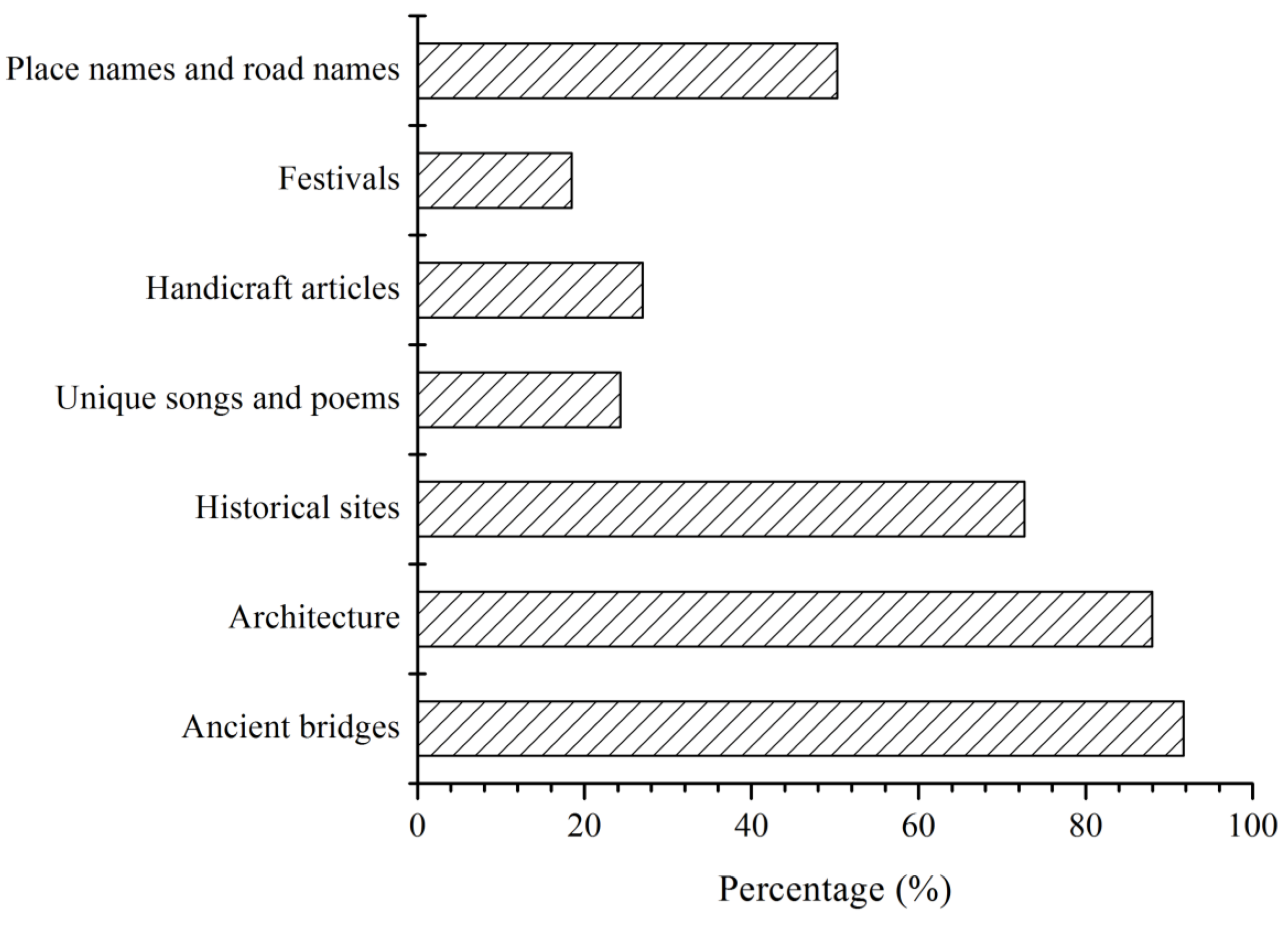
| Government’s Degree of Protection | Satisfaction with Current Situation | ||||
|---|---|---|---|---|---|
| Options | Number | Percentage (%) | Options | Number | Percentage (%) |
| Powerful | 64 | 12.05 | Satisfied | 34 | 6.40 |
| Not bad | 285 | 53.67 | Tolerable | 402 | 75.71 |
| Weak | 114 | 21.47 | Disappointed | 94 | 17.70 |
| Not clear | 68 | 12.81 | |||
4.5. Estimation of WTP and the Total Benefit
| Bid Amount | 2 | 5 | 10 | 20 | 50 | 100 | 200 | 500 | Sum |
|---|---|---|---|---|---|---|---|---|---|
| Sample size | 73 | 70 | 72 | 71 | 70 | 68 | 59 | 48 | 531 |
| WTP > 0 | 49 | 63 | 49 | 53 | 46 | 48 | 35 | 30 | 373 |
| WTP = 0 | 24 | 7 | 23 | 18 | 24 | 20 | 24 | 18 | 158 |
| Y(WTP > 0)% | 95.92 | 96.83 | 87.76 | 84.91 | 71.74 | 54.17 | 22.86 | 16.67 | |
| N(WTP = 0)% | 4.08 | 3.17 | 12.24 | 15.09 | 28.26 | 45.83 | 77.14 | 83.33 |
4.6. Factors Influencing WTP
| B | S.E. | Wals | df | Significance | Exp (B) | |
|---|---|---|---|---|---|---|
| AGE | 0.024 | 0.115 | 0.044 | 1 | 0.834 | 1.024 |
| JOB | 0.019 | 0.054 | 0.116 | 1 | 0.734 | 1.019 |
| EDU (educational level) | −0.007 | 0.138 | 0.002 | 1 | 0.960 | 0.993 |
| PEO (household population) | −0.046 | 0.132 | 0.120 | 1 | 0.729 | 0.955 |
| INC (household income) | 0.108 | 0.071 | 2.326 | 1 | 0.127 | 1.114 |
| DIS (distance from river) | −0.241 | 0.091 | 7.101 | 1 | 0.008 | 0.786 |
| LYS (years in Shanghai) | −0.234 | 0.114 | 4.208 | 1 | 0.040 | 0.792 |
| PRO (environmentally related job) | −0.038 | 0.297 | 0.017 | 1 | 0.898 | 0.963 |
| A (payment amount) | −0.012 | 0.002 | 48.345 | 1 | 0.000 | 0.988 |
| Constant | 2.649 | 1.063 | 6.215 | 1 | 0.013 | 14.140 |
| 2LogLikelihood | 325.502 | |||||
| Cox & Snell R Squared | 0.271 | |||||
4.7. Regional Difference in WTP
| Area | B | S.E. | Wals | df | Significance | Exp (B) | |
|---|---|---|---|---|---|---|---|
| Urban area | A (payment amount) | −0.010 | 0.002 | 18.864 | 1 | 0.000 | 0.990 |
| Constant | −0.936 | 1.770 | 0.279 | 1 | 0.597 | 0.392 | |
| 2LogLikelihood | 127.678 | ||||||
| Cox & Snell R Squared | 0.235 | ||||||
| Suburban | A(payment amount) | −0.007 | 0.001 | 36.247 | 1 | 0.000 | 0.993 |
| Constant | 4.372 | 1.222 | 12.802 | 1 | 0.000 | 79.223 | |
| 2LogLikelihood | 269.420 | ||||||
| Cox & Snell R Squared | 0.213 | ||||||
4. Conclusions and Recommendations
- (1) The river network was valued by most local residents in Shanghai, and its eco-environmental value was the most important of the values examined. Water quality and aquatic life were the aspects of the river network that were ranked most highly, and river connectivity ranked higher than river structure and quantity.
- (2) The functions of the river network as a drinking water resource and as a place used for entertainment were the most frequently recognized services furnished by the river network. In the area of entertainment, indirect uses were more frequently cited than direct uses.
- (3) The destruction of the river network and the degradation of its functions have attracted wide public attention. Decreases in water quality and channel blockage were the most frequently cited forms of deterioration. Material elements of culture, such as bridges, architectures and historical sites, were the focal points in the area of cultural loss. Few residents were satisfied with the current situation and the protection given by the government. More powerful and effective actions for river network protection are needed.
- (4) The mean WTP in the study area was 226.44 RMB per household per month, or 22.43 billion RMB per year within the boundaries of Shanghai. The number of years lived in Shanghai, the distance from the home to the nearest river and the amount of the bid were factors that significantly affected the WTP. The analysis also found a significant difference in the WTP between the urban and suburban areas. This difference was not consistent with the difference in the income levels between these areas.
- (1) The water quality in Shanghai has shown improvement after the development of pollution control projects over the past few decades. In the coming years, the government should begin to shift the target of protection from the simple improvement of water quality to the integrated restoration of the entire river network, including its structure and connectivity. Such ideas should be promoted to convince the public. Because the indirect entertainment services along the riverside are most important, measures should be taken to provide ecological passageways, platforms, and waterfront green space.
- (2) Because of the unique eco-environmental and cultural characteristics of Shanghai, the protection of the river network should be combined with the protection of culture and the development of tourism. The local government should gradually restore the historical features related to the river network.
- (3) The results of the study show that a large proportion of the local residents are willing to pay for river network improvement and protection, thus, economic policy is identified as a flexible instrument for river network management. Efforts to assess and evaluate the status of the river network need to be initiated, and market-based policy should be proposed based on a larger sample collected in selected districts. Ecological compensation or a reward mechanism based on the CVM results might be introduced to support protection.
Acknowledgments
Conflict of Interest
References and Notes
- Ruan, Y.S.; Yuan, F. To the new age of Jiangnan ancient water towns: Protection and proper development of ancient water towns in Jiangnan. Urban Plan. Forum 2010, 2, 35–40. (in Chinese). [Google Scholar]
- Muneepeerakul, R.; Bertuzzo, E.; Rinaldo, A.; Rodriguez-Iturbe, I. Patterns of vegetation biodiversity: The roles of dispersal directionality and river network structure. J. Theor. Biol. 2008, 252, 221–229. [Google Scholar] [CrossRef]
- Wang, X.M.; Hao, R.; Huo, J.; Zhang, J.F. Modeling sediment transport in river networks. Physica A 2008, 387, 6421–6430. [Google Scholar] [CrossRef]
- Huang, Y.; Jiang, D.; Zhuang, D.; Fu, J. Evaluation of hyperspectral indices for chlorophyll-a concentration estimation in Tangxun Lake (Wuhan, China). Int. J. Environ. Res. Public Health 2010, 7, 2437–2451. [Google Scholar] [CrossRef]
- Yang, X.Y.; Jin, W. GIS-based spatial regression and prediction of water quality in river networks: A case study in Iowa. J. Environ. Manage. 2010, 91, 1943–1951. [Google Scholar] [CrossRef]
- Neeson, T.M.; Wiley, M.J.; Adlerstein, S.A.; Riolo, R.L. River network structure shapes inter-annual feedbacks between adult sea lamprey migration and larval habitation. Ecol. Model. 2011, 222, 3181–3192. [Google Scholar] [CrossRef]
- Wu, M.; Wang, Y.; Dong, J.; Sun, C.; Wang, Y.; Sun, F.; Cheng, H. Investigation of spatial and temporal trends in water quality in Daya Bay, South China Sea. Int. J. Environ. Res. Public Health 2011, 8, 2352–2365. [Google Scholar] [CrossRef]
- Mitchell, R.C.; Carson, R.T. Using Surveys to Value Public Goods: The Contingent Valuation Method (Resources for the Future); RFF Press: Washington, DC, USA, 1989; pp. 15–52. [Google Scholar]
- Davis, R.K. The Value of Outdoor Recreation: An Economic Study of the Maine Woods; Unpublished Ph.D. Dissertation, Harvard University, Cambridge, MA, USA, 1963.
- Arrow, K.J.; Solow, R.S.; Leamer, E.; Portney, P.; Radner, R.; Schuman, H. Report of the NOAA Panel on Contingent Valuation, Federal Register 58; CSUEB: Hayward, CA, USA, 1993. [Google Scholar]
- Xu, Z.M.; Cheng, G.D.; Zhang, Z.Q.; Su, Z.Y.; Loomis, J. Applying contingent valuation in China to measure the total economic value of restoring ecosystem services in Ejina region. Ecol. Econ. 2003, 44, 345–358. [Google Scholar] [CrossRef]
- Bateman, I.J.; Cole, M.A.; Georgiou, S.; Hadley, D.J. Comparing contingent valuation and contingent ranking: A case study considering the benefits of urban river water quality improvements. J. Environ. Manage. 2006, 79, 221–231. [Google Scholar] [CrossRef]
- Gürlük, S. The estimation of ecosystem services’ value in the region of Misi rural development project: Results from a contingent valuation survey. Forest Policy Econ. 2006, 9, 209–218. [Google Scholar] [CrossRef]
- Wang, X.J.; Zhang, W.; Li, Y.; Yang, K.Z.; Bai, M. Air quality improvement estimation and assessment using contingent valuation method: A case study in Beijing. Environ. Monit. Assess. 2006, 120, 153–168. [Google Scholar] [CrossRef]
- García-Llorente, M.; Martín-López, B.; González, J.A.; Alcorlo, P.; Montes, C. Social perceptions of the impacts and benefits of invasive alien species: Implications for management. Biol. Conserv. 2008, 141, 2969–2983. [Google Scholar] [CrossRef]
- Antony, J.; Rao, A. Contingent Valuation: A Review with Emphasis on Estimation Procedures. Available online: http://interstat.statjournals.net/YEAR/2010/articles/1007004.pdf (accessed on 24 October 2012).
- Salam, M.A.; Noguchi, T.; Alim, M.A. Factors affecting participating farmer’s willingness to pay for the tree farming fund: A study in a participatory forest in Bangladesh. Environ. Monit. Assess. 2006, 118, 165–178. [Google Scholar] [CrossRef]
- Afroz, R.; Hanaki, K.; Tudin, R. Factors affecting waste generation: A study in waste management program in Dhaka City, Bangladesh. Environ. Monit. Assess. 2011, 179, 509–519. [Google Scholar] [CrossRef]
- Kohlmann, B.; Mitsch, W.J.; Hansen, D.O. Ecological management and sustainable development in the humid tropics of Costa Rica. Ecol. Eng. 2008, 34, 254–266. [Google Scholar] [CrossRef]
- Buijs, A.E. Public support for river restoration. A mixed-method study into local residents’ support for and framing of river management and ecological restoration in the Dutch floodplains. J. Environ. Manag. 2009, 90, 2680–2689. [Google Scholar] [CrossRef]
- Loomis, J.; Kent, P.; Strange, L.; Fausch, K.; Covich, A. Measuring the total economic value of restoring ecosystem services in an impaired river basin: Results from a contingent valuation survey. Ecol. Econ. 2000, 33, 103–117. [Google Scholar] [CrossRef]
- Van der Heide, C.M.; van der Bergh, J.C.J.M.; van Ierland, E.C.; Nunes, P.A.L.D. Economic valuation of habitat defragmentation: A study of the Veluwe, the Netherlands. Ecol. Econ. 2008, 67, 205–216. [Google Scholar] [CrossRef]
- Amigues, J.P.; Boulatoff, C.; Desaigues, B.; Gauthier, C.; Keith, J.E. The benefits and costs of riparian analysis habitat preservation: A willingness to accept/willingness to pay contingent valuation approach. Ecol. Econ. 2002, 43, 17–31. [Google Scholar] [CrossRef]
- Holmes, T.P.; Bergstrom, J.C.; Huszar, E.; Kask, S.B.; Orr, F., III. Contingent valuation, net marginal benefits, and the scale of riparian ecosystem restoration. Ecol. Econ. 2004, 49, 19–30. [Google Scholar] [CrossRef]
- Desvousges, W.H.; Smith, V.K.; Fisher, A. Option price estimates for water quality improvements: A contingent valuation study for the Monongahela River. J. Environ. Econ. Manag. 1987, 14, 248–267. [Google Scholar] [CrossRef]
- Lichtkoppler, F.R.; Blaine, T.W. Environmental awareness and attitudes of Ashtabula county voters concerning the Ashtabula river area of concern: 1996–1997. J. Great Lakes Res. 1999, 25, 500–514. [Google Scholar] [CrossRef]
- Urama, K.C.; Hodge, I.D. Are stated preferences convergent with revealed preferences? Empirical evidence from Nigeria. Environ. Impact Assess. Rev. 2006, 59, 24–37. [Google Scholar]
- Jiang, Y.; Jin, L.S.; Lin, T. Higher water tariffs for less river pollution-Evidence from the Min River and Fuzhou City in China. China Econ. Rev. 2011, 22, 183–195. [Google Scholar] [CrossRef]
- Willis, K.G.; Garrod, G.D. Angling and recreation values of low-flow alleviation in rivers. J. Environ. Manag. 1999, 57, 71–83. [Google Scholar] [CrossRef]
- Berrens, R.P.; Bohara, A.K.; Silva, C.L.; Brookshire, D.; McKee, M. Contingent values for New Mexico in stream flows: With tests of scope, group-size reminder and temporal reliability. J. Environ. Manage. 2000, 58, 73–90. [Google Scholar] [CrossRef]
- Ojeda, M.I.; Mayer, A.S.; Solomon, B.D. Economic valuation of environmental services sustained by water flows in the Yaqui River Delta. Ecol. Econ. 2008, 65, 155–166. [Google Scholar] [CrossRef]
- Carson, R.; Hanemann, M.; Steinberg, D. A discrete choice contingent valuation estimate of the value of Kenai King salmon. J. Behav. 1990, 19, 53–68. [Google Scholar]
- Thomas, R.H.; Blakemore, F.B. Elements of a cost-benefit analysis for improving salmonid spawning habitat in the River Wye. J. Environ. Manage. 2007, 82, 471–480. [Google Scholar] [CrossRef]
- Clayton, C.; Mendelsohn, R. The value of watchable wildlife: A case study of McNeil River. J. Environ. Manage. 1993, 39, 101–106. [Google Scholar] [CrossRef]
- Corrigan, J.R.; Egan, K.J.; Downing, J.A. Aesthetic Values of Lakes and Rivers; Elsevier: Amsterdam, Holland, 2009; pp. 14–25. [Google Scholar]
- Shanghai Water Authority, Shanghai River Survey Report in 2006; Shanghai Water Authority: Shanghai, China, 2006; pp. 1–6.
- Zhang, Y.; Wang, Y.; Ye, W.H. Surface water quality changes in Shanghai City in past 20 years. Acta Scientiae Circumstantiae 2002, 22, 247–251. (in Chinese). [Google Scholar]
- Venkatachalam, L. The contingent valuation method: A review. Environ. Impact Assess. Rev. 2004, 24, 89–124. [Google Scholar] [CrossRef]
- Kima, S.S.; Wongb, K.K.F.; Choa, M. Assessing the economic value of a world heritage site and willingness to pay determinants: A case of Changdeok Palace. Tourism Manag. 2007, 28, 317–322. [Google Scholar] [CrossRef]
- Ramajo-Hernandez, J.; Saz-Salazar, S. Estimating the non-market benefits of water quality improvement for a case study in Spain: A contingent valuation approach. Environ. Sci. Policy. 2012, 22, 47–59. [Google Scholar] [CrossRef]
- Ojeda, M.I.; Mayer, A.S.; Solomon, B.D. Economic valuation of environmental services sustained by water flows in the Yaqui River Delta. Ecol. Econ. 2008, 65, 155–166. [Google Scholar] [CrossRef]
- Saz-Salazar, S.; Hernández-Sancho, F.; Sala-Garrido, R. The social benefits of restoring water quality in the context of the water framework directive: A comparison of willingness to pay and willingness to accept. Sci. Total. Environ. 2009, 407, 4574–4583. [Google Scholar] [CrossRef]
- Johannesson, M.; Johansson, P.O.; Kristrom, B.; Gerdtham, U.G. Willingness to pay for antihypertensive therapy—Further results. J. Health. Econ. 1993, 12, 95–108. [Google Scholar] [CrossRef]
- Ryan, M. Valuing psychological factors in the provision of assisted reproductive techniques using the economic instrument of willingness to pay. J. Econ. Psycholy. 1998, 19, 179–204. [Google Scholar] [CrossRef]
- Dutta, M.; Banerjee, S.; Hussain, Z. Untapped demand for heritage: A contigent valuation study of Prinsep Ghat, Calcutta. Tourism Manag. 2007, 28, 83–95. [Google Scholar] [CrossRef]
- Hanemann, W.M. Welfare valuations in contingent valuation experiments with discrete responses. Am. J. Agr. Econ. 1984, 66, 332–341. [Google Scholar] [CrossRef]
- Hanemann, W.M. Welfare valuations in contingent valuation experiments with discrete response data. Am. J. Agr. Econ. 1989, 71, 1057–1061. [Google Scholar] [CrossRef]
- Maslow, A.H. A Theory of Human Motivation. Psychol. Rev. 1943, 50, 370–396. [Google Scholar] [CrossRef]
- Che, Y.; Yang, K.; Chen, T.; Xu, Q. Assessing a riverfront rehabilitation project using the comprehensive index of public accessibility. Ecol. Eng. 2012, 40, 80–87. [Google Scholar] [CrossRef]
- Liu, C.; Jin, Y.; Yang, K.; Che, Y. Protection of ancient water town’s view and culture based on river network: A case study of Zhujiajiao. World Regional Studies 2011, 2, 171–178. (in Chinese). [Google Scholar]
- Gonzalez-Caban, A.; Loomis, J.B.; Rodriguez, A.; Hesseln, H. A comparison of CVM survey response rates, protests and willingness-to-pay of Native Americans and general population for fuels reduction policies. J. Forest. Eco. 2007, 13, 49–71. [Google Scholar]
- Bateman, I.J.; Carson, R.T.; Day, B.; Hanemann, W.M.; Hanley, N.; Hett, T.; Jones-Lee, M.; Loomes, G.; Mourato, S.; Ozdemiroglu, E.; et al. Economic Valuation with Stated Preference Techniques: A Manual; Edward Elgar, Ltd.: Cheltenham, UK, 2002; pp. 5–35. [Google Scholar]
- García-Llorente, M.; Martín-López, B.; Nunes, P.A.; González, J.A.; Alcorlo, P.; Montes, C. Analyzing the social factors that influence willingness to pay for invasive alien species management under two different strategies: Eradication and prevention. Environ. Manag. 2011, 48, 418–435. [Google Scholar]
- Heckman, I. Dummy exogenous variables in a simulation equation system. Econometrica 1978, 46, 403–426. [Google Scholar] [CrossRef]
© 2012 by the authors; licensee MDPI, Basel, Switzerland. This article is an open-access article distributed under the terms and conditions of the Creative Commons Attribution license (http://creativecommons.org/licenses/by/3.0/).
Share and Cite
Shang, Z.; Che, Y.; Yang, K.; Jiang, Y. Assessing Local Communities’ Willingness to Pay for River Network Protection: A Contingent Valuation Study of Shanghai, China. Int. J. Environ. Res. Public Health 2012, 9, 3866-3882. https://doi.org/10.3390/ijerph9113866
Shang Z, Che Y, Yang K, Jiang Y. Assessing Local Communities’ Willingness to Pay for River Network Protection: A Contingent Valuation Study of Shanghai, China. International Journal of Environmental Research and Public Health. 2012; 9(11):3866-3882. https://doi.org/10.3390/ijerph9113866
Chicago/Turabian StyleShang, Zhaoyi, Yue Che, Kai Yang, and Yu Jiang. 2012. "Assessing Local Communities’ Willingness to Pay for River Network Protection: A Contingent Valuation Study of Shanghai, China" International Journal of Environmental Research and Public Health 9, no. 11: 3866-3882. https://doi.org/10.3390/ijerph9113866




